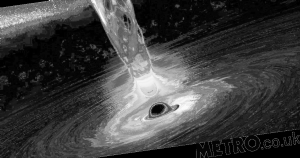The gigantic black hole which lurks at the core of humanity’s home galaxy has suddenly awoken and gone into a feeding frenzy.
Sagitarrius A* is the nearest supermassive hole to Earth and is usually more of a slumbering beast than a ravenous monster.
But it suddenly appears to be ‘getting hungrier’ and is wolfing down vast amounts of gas, dust and anything else unfortunate enough to be nearby.
‘We have never seen anything like this in the 24 years we have studied the supermassive black hole,’ said Andrea Ghez, UCLA professor of physics and astronomy and a co-senior author of the research exposing the behemoths monumental appetite.
‘It’s usually a pretty quiet, wimpy black hole on a diet. We don’t know what is driving this big feast.’
Astronomers carried out 13,000 observations of the supermassive black hole on 133 different night since 2013.
Earlier this year, it was spotted glowing twice as brightly as usual, with the strange light emanating outside its ‘point of no return’ beyond which no matter can escape.
This change was ‘unprecedented’, Ghez said, but it’s not known whether the colossus is about to start gorging itself or if the glow was caused by a large one-off meal of gas and dust.
‘The big question is whether the black hole is entering a new phase – for example if the spigot has been turned up and the rate of gas falling down the black hole “drain” has increased for an extended period – or whether we have just seen the fireworks from a few unusual blobs of gas falling in,’ said Mark Morris, UCLA professor of physics and astronomy and the paper’s co-senior author.
Stargazers will continue to observe the monster and try to work out whether its ravenous greed will grow and grow.
‘We want to know how black holes grow and affect the evolution of galaxies and the universe,’ Ghez added.
‘We want to know why the supermassive hole gets brighter and how it gets brighter.’
The black hole was spotted glowing strangely over four nights in April and May by astronomers at at the Keck Observatory.
Its brightness aways varies somewhat, but the scientists were ‘stunned by the extreme variations’.
Black holes do not shine, because not even light can escape their greedy maw.
But the gas, dust and other material surrounding them is often heated up and tugged around by gravity until it glows. This effect can be seen vividly in the first-ever image of a black hole, which was captured earlier this year.
There are several possible explanations for the hole’s strange behaviour.
It could have sucked gas from the surface of a star called S0-2, which zoomed past last summer and let loose a mighty belch of gas which may have just reached Sagittarius A*.
Another possibility involves a ‘bizarre object’ known as G2, which is probably a pair of binary stars (systems made of two stars orbiting each other).
This strange system made a close approach to the black hole in 2014 and it’s possible the dark destroyer sucked gas from the stars.
It may even have swallowed up a load of asteroids.
‘The first image I saw that night, the black hole was so bright I initially mistook it for the star S0-2, because I had never seen Sagittarius A* that bright,’ said UCLA research scientist Tuan Do, the study’s lead author.
‘But it quickly became clear the source had to be the black hole, which was really exciting.’
We’re glad to report that no matter how hungry Sagitarrius A* becomes, it is highly unlikely to eat Earth because it’s a whopping 25,640 light-years away.
Do said the radiation would have to be 10 billion times as bright as what the astronomers detected to affect life on Earth.
Source: Read Full Article

